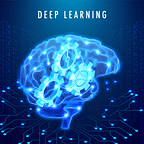Deep learning: Neurons part 2
Neurons are cells within the nervous system that transmit information to other nerve cells, muscle, or gland cells
So, here’s our neuron, also sometimes called the node.
The neuron gets some input signals. And it has an output signal.
So dendrites and axons? But again, we’re gonna call these synopses.
These input signals, we’re going to represent them with
other neurons as well.
In this green neuron is getting signals from yellow neurons. where yellow means an input layer. So basically all the neurons that are on the outer layer, on the first front of where the signals coming in.
By signal, it might be a bit of an overkill to call this a signal.
It’s just basically input value. So you know how even like in a simple
linear regression you have input values, and then you have a predicted value.
So you have input values, and there they are the yellow ones.
it’ll be red, it’ll be the output value. The thing that I wanted to point out here is that in this specific example we are looking at a neuron that is getting its signals from the input layer neurons. So they are also neurons but
they are input layer neurons.
Sometimes you’ll have neurons that get their signal from other hidden layer neurons, so from other green neurons. And the concept is gonna be exactly the same. And in terms of the input layer, the way to think about it is in the analogy of the human brain, the input layer is your senses, right.
So whatever you can see, hear, feel touch, or smell. And of course,
there’s a lot of information coming in. But those are yours…
that’s what your brain is limited to, just think your brain is locked in a black box and it can’t see, it can’t hear, the only thing it’s getting is electrical impulses coming from these organs that you have, which are called your ears, nose, eyes, your sense of touch and whatever and your taste.
It’s just getting signals but basically lives in this dark black box
and it’s making sense of the world through your senses.
So you have these inputs that are coming in, and in terms of the human brain those are your five senses, in terms of machine learning or deep learning,
that is basically your input values, so your independent variables,
So your input values, the signal is passed through synapses to your neuron,
and then your neuron has an output value, that it passes further on down the chain.
In terms of color-coding, again yellow means the input layer.
then we’re gonna have one hidden layer, with the green, which is a hidden layer, and then we’re gonna have our output layer right away.
Well, we have these inputs which are independent variables.
So independent variable one, independent variable two,
and independent variable m. The important thing to remember here
is that these independent variables are all for one single observation.
So think of it as one row in your database. One observation.
You just take all of the independent variables, maybe it’s the age of the person, the amount of money in their bank account, how do they drive or walk to work, what method of transportation do they use. But that’s all descriptions of one specific person, that you are, either you’re training your model on, or you’re performing some prediction on. And the other thing you need to know about these variables is that you need to standardize them which means making sure they have a mean of zero and variance one, sometimes you might wanna normalize them. Meaning that instead of making sure that mean is zero and variance is one, you just subtract the minimum value, and then you divide it by maximum minus minimum, so by the range of your values and therefore you get values between zero and one. Depend on the scenario you might wanna all of these variables to be quite similar in about the same range of values.
